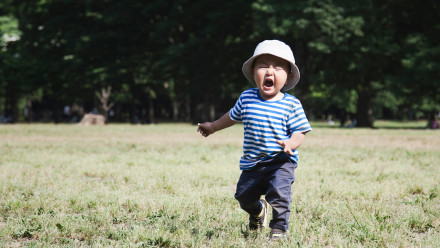Photo: iStockphoto
Five-year-old Dawson Gardiner isn’t keen about bugs. In fact, if he sees a spider, his first impulse is to step on it. “I always say, ‘Don’t do that; the spider won’t hurt you. He’s more afraid of you than you are of him,’” says his mom, Stephanie.
Why are many preschoolers frightened of insects and spiders? “We’re afraid of the things we don’t know about,” says Sabeena Esposito, a biologist with Bugs Without Borders, a Toronto-based organization that helps kids (and adults alike) learn more about the weird and wonderful world of bugs. “Little kids don’t know what these quick, small creatures are, and often the adults react quite negatively as well.” Getting up close and personal with a few creepy-crawlies can help, says Esposito. Here’s how to do it in a kind and gentle way:
1. Observe and collect
Go out in your backyard and notice the ladybugs eating the aphids in the garden. Watch the dragonflies catch mosquitoes over the lake. Lie on a blanket on a midsummer night and enjoy the dance of the fireflies.
For an even closer look, Esposito recommends collecting non-flying insects. Leave flying critters alone because trapping them can be injurious and unkind. Monarch butterflies, for instance, will die if you try to keep them because they’re programmed to migrate. If your child does capture one of these, encourage her to let it go.
2. Nurture and study
A plastic container, with a few air holes punched in the lid, makes a good terrarium. Little nets are useful tools for junior entomologists. Create a habitat with soil, twigs, leaves and stones so that the bugs will have hiding places. Potato bugs, beetles and ladybugs are good candidates for observation. Although snails aren’t insects, they’ll cohabit peacefully with these bugs and are fun to observe. You may need a field guide for identification. Or go online for many good sources of info (such as insectidentification.org). A bit of potato or carrot provides both food and water for the insects; snails like to munch on lettuce.

The ultimate guide to mosquito bitesNow get out the magnifying glass. Notice colour and shape, and how beautiful—or fierce—they look. After a few days, return your study subjects to the place you collected them.
An ant farm is another great way for kids to study insects. “You can see how intricate their homes are, and how much energy goes into building,” says Esposito. Your child can watch the worker ants as they tunnel, notice when they eat and sleep, and find the queen in her separate quarters.
If you want to observe metamorphosis (the process by which a creature changes from one form to another), buy a few mealworms from a pet store. “Ask for the small ones,” says Esposito, “and put them in a terrarium with some bran cereal and potato or carrot. You’ll see them moving around and after a few days, they will go into a pupa. A few weeks later, a darkling beetle will emerge.”
Esposito doesn’t recommend collecting spiders. “They are carnivores and will eat the other insects in your terrarium,” says Esposito. “People are often very nervous about spiders. You can explain that the ones in our houses actually eat other insects, so they can be helpful in that way.” Try heading out to a natural area after a rainfall to find a glistening web.
3. Bee calm
If you stay calm around insects—especially bees and wasps—chances are your child will learn to do the same. Esposito says she’s never been stung in 15 years — and she lets bees land on her. “The bee is just curious: It’s checking you out with regard to smell and taste. If you wave your arms around and brush at the bee, it’s liable to sting because it’s threatened,” says Esposito.
Parents can also alleviate fears about insects and other creepy-crawlies by pointing out how important they are—that without them, the intricate web of life on which we depend would collapse. “Bees make honey and they also pollinate. Without them and many other insects, we wouldn’t have any fruits and vegetables,” says Esposito. “We share a planet with them. I always tell kids, our homes are built on their homes.”
Read more:
An age-by-age guide to kids’ phobias
Throw a garden-themed birthday party


